| Columns Retired Columns & Blogs |
This loudspeaker would be the only LS3/5a to be in the Stereophile Class A Recommended Component List rating.
Just preliminary checking. It is an excellent review about a pair of loudspeaker.
Thanks to Falcon.
In the April 2021 issue of Stereophile, Herb Reichert wrote that he'd spent "almost 40 continuous years using first the kit, then the Rogers, then the Falcon LS3/5a's. Now, a new 5a has entered my world. It is what Falcon calls the 'Gold Badge' version ($2999/pair), and I think it might be the best LS3/5a ever produced for general consumption." The Falcon Acoustics' Gold Badge LS3/5a is a new version of the Falcon LS3/5a Herb reviewed in the July 2015 issue and which he has been using ever since.
Herb tried driving the new Falcons with a variety of amplifiers and concluded, "No matter which amp I was using, every time I put the new Falcon LS3/5a Gold Badges in the system, I did not want to take them out. I did not want to lose their beautifully balanced, let-out-my-breath, forget-about-audio just-rightness."
The LS3/5a has been in continuous production, in one form or another, for almost 46 years. I can't think of another design from the 1970s that is still competitive with modern loudspeakers. Some background is in order:
In the early 1970s, the BBC in the UK needed a small on-location monitor that would provide consistent reproduction in small, suboptimal environments such as a recording truck. A team led by T. Sommerville and D.E. Shorter, of the BBC's Research Department, based the LS3/5 on a small monitor they had designed for acoustic scaling experiments. That monitor used a B110 woofer with a doped Bextrene cone and a T27 SP1032 Mylar-dome tweeter, both sourced from British manufacturer KEF (footnote 1). The speaker showed much promise, but problems with the drive-units led to a detailed redesign, which was carried out by Dudley Harwood of the BBC's Research Department and Maurice E. Whatton and R.W. Mills of the Designs Department. The result was the LS3/5a, and the BBC licensed the design to several manufacturers, most recently Falcon, Graham, and the revitalized Rogers company (footnote 2).
I own a 1978 pair of Rogers LS3/5a's and have been using them as a reference ever since Stereophile started publishing loudspeaker measurements in 1989. Before I perform the measurements of a loudspeaker under review, I measure the on-axis response and sensitivity of one of those 1978 speakers. I do this to ensure that a systematic error has not crept into my speaker measurements. If the LS3/5a continues to measure identically, then I can be sure that nothing has gone wrong with my test gear: microphone, mike preamp, power amplifier, etc.

The quasi-anechoic frequency response of my Rogers LS3/5a, averaged across a 30° horizontal window centered on the tweeter axis and spliced below 300Hz to the nearfield woofer response, is shown in fig.1. Small peaks in the upper bass and just above 1kHz are set against a gently rising trend in the treble; the overall response is otherwise even and smooth. While the low-frequency output is restricted—this is a small loudspeaker—the sealed-box alignment means that the bass rolls off more slowly than a typical ported design, with a 12dB/octave slope rather than 24dB/octave.
After HR had written his review of the Falcon LS3/5a Gold Badge, I used DRA Labs' MLSSA system and a calibrated DPA 4006 microphone to measure the loudspeaker's frequency response in the farfield and an Earthworks QTC-40 mike for the nearfield and in-room responses. (The grille was left in place for all the acoustic measurements, as recommended in the Gold Badge's manual.) I measured the speaker's impedance with Dayton Audio's DATS V2 system, checking the results with MLSSA.
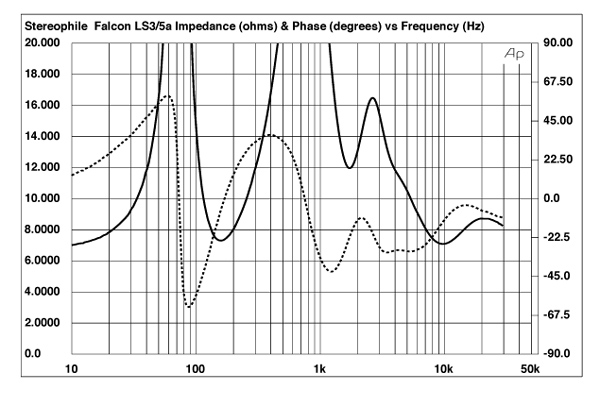
Falcon specifies the LS3/5a Gold Badge's sensitivity as a low 83dB/2.83V/m. My estimate was within experimental error of that figure, at 82.7dB(B)/2.83V/m. The LS3/5a Gold Badge's impedance is specified as 15 ohms. As measured, the impedance magnitude (fig.2, solid trace) remains above 8 ohms for almost the entire audioband and lies above 12 ohms between 40Hz and 105Hz and between 300Hz and 3kHz. While the minimum impedance is a still-high 7.3 ohms at 157Hz, the electrical phase angle (dashed trace) is occasionally high. Even so, the EPDR (footnote 3) is 3.4–4.0 ohms below 60Hz and 3.3 ohms between 117Hz and 121Hz. The LS3/5a Gold Badge is a relatively easy load.

The traces in fig.2 are free from the small discontinuities that would imply resonances of some kind. I investigated the enclosure's vibrational behavior with a plastic-tape accelerometer and the speaker supported on upturned cones, which allows resonances to fully develop. Other than a negligible amount of flexing at the woofer's tuning frequency, the only resonant modes I found were in the midrange on the sidewalls (fig.3). These modes have a high Q (Quality Factor) and a very low level, both of which will minimize their audibility. The Gold Badge's enclosure is significantly better-behaved than that of Falcon's 2015 LS3/5a.
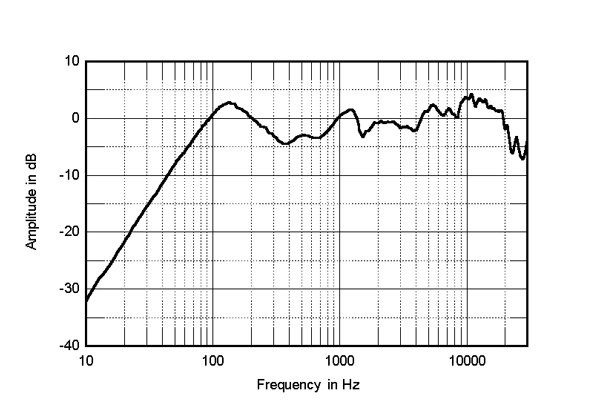
Comparing fig.4 with fig.1, the Gold Badge LS3/5a's upper bass can be seen to be a little higher in level than that of the 1978 LS3/5a. In part, this will be due to the nearfield measurement, which assumes that the woofer is mounted in a true infinite baffle, ie, one that extends to infinity in both planes. It suggests, however, that the new speaker's alignment is less well-damped than that of the older speaker.
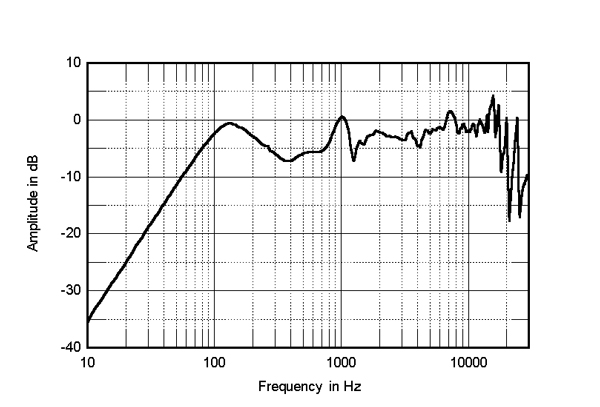
Higher in frequency in fig.4, the Falcon's farfield response, averaged across a 30° horizontal window centered on the tweeter axis, is not quite as even as that of the 1978 LS3/5a. However, it is smoother than that of the 2015 Falcon LS3/5a (fig.5), and the small peak between 900Hz and 1.8kHz is slightly higher in frequency and lower in amplitude than that of the older speaker. The new speaker's output above 15kHz is also better-behaved than that of the 2015 speaker.
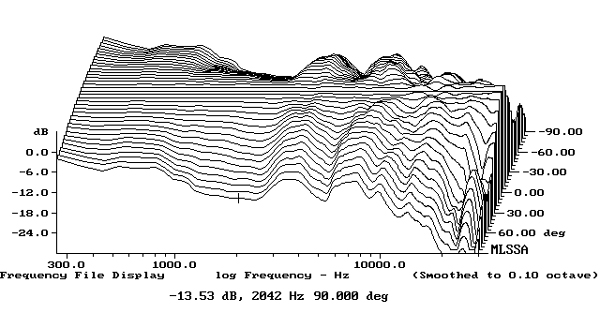
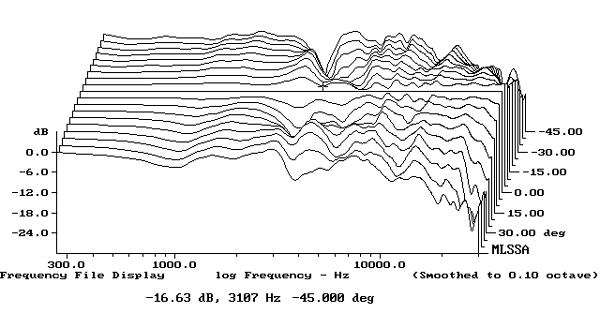
Fig.6 shows the LS3/5a Gold Badge's horizontal dispersion, normalized to the response on the tweeter axis, which thus appears as a straight line (footnote 4). The loudspeaker's radiation pattern narrows at the top of the woofer's passband, which might make the speaker sound a little polite. Small dips in the lower treble in the on-axis response fill in to the sides. In the vertical plane (fig.7), a suckout in the crossover region develops more than 10° above and 5° below the tweeter axis. Falcon recommends using 24" stands with the LS3/5a, which will place the tweeter 35.5" from the floor—just below the height of an average listener's ears. Don't listen to the Falcons in a chair that's too high or use stands that are much taller or shorter than 24".
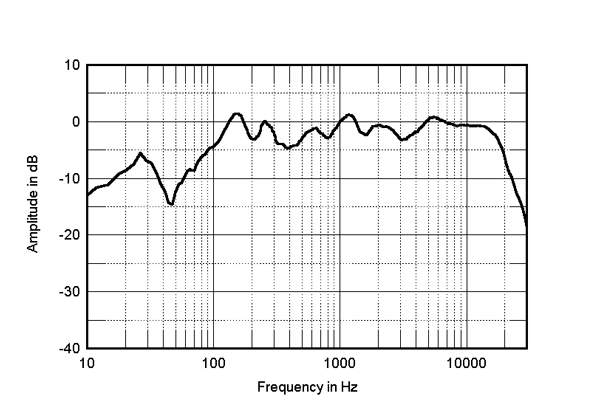
The Falcon LS3/5a Gold Badges' spatially averaged response in my room is shown in fig.8. The spatial averaging (footnote 5) tends to average out the peaks and dips below 400Hz that are due to the room's resonant modes. A loudspeaker that offers a flat on-axis response and well-controlled lateral dispersion gives a gently sloped-down treble in the spatially averaged room response, due primarily to the increased absorption of the room's furnishings at high frequencies. By that criterion, the LS3/5a Gold Badge produces a little too much energy in-room in the top two audio octaves. There is a small peak in the upper bass, but as the sealed-box rolloff is relatively gentle, the Falcons still excite the lowest-frequency room resonance around 30Hz, as do the 1978 Rogers LS3/5a's (fig.9, blue trace).

This graph also shows that the Falcons' in-room behavior (red trace) is very similar to that of the Rogers. The Falcons produce a little less midbass energy, however, which I suspect is due to the new speakers being a little farther away from the wall behind them than the older ones, which I had measured in 2017.

Fig.10 repeats the spatially averaged responses of the LS3/5a Gold Badges (red trace) and the 1978 LS3/5a's (blue trace), but with an expanded vertical scale. It also compares those responses with that of the KEF LS50 Metas I reviewed in January 2021 (green trace). The KEFs and Falcons were in very similar positions in my room.
Choosing at which frequency to normalize the responses in graphs like this is tricky. With loudspeakers that have "lumpy" in-room responses—and they all do—which frequency region the ear hears as the reference depends very much on the type of music being played. I decided to make the traces equal in level at 1kHz, which also makes the levels of the three speakers' mid-treble region and the peaks in the upper-bass very similar. The reflex-loaded KEFs have more mid-bass output than the two LS3/5a's, but their faster low-frequency rolloff means that they don't excite the 30Hz room resonance. While the Falcons have less presence-region energy than the KEFs and Rogers, the KEFs have less top-octave energy than the two LS3/5a versions.
Choosing 1kHz to normalize the traces makes it look as if the KEFs have considerably more output in the midrange. However, when I listened to the 1978 LS3/5a's and LS50 Metas, the KEFs had a noticeably lower high treble, which suggests that I was hearing their midrange as being correct with the music I was playing. The slight lack of midrange energy with both versions of the LS3/5a might make the treble sound a touch exaggerated, though with the elevated upper bass, this classic "smile" balance will flatter many recordings.
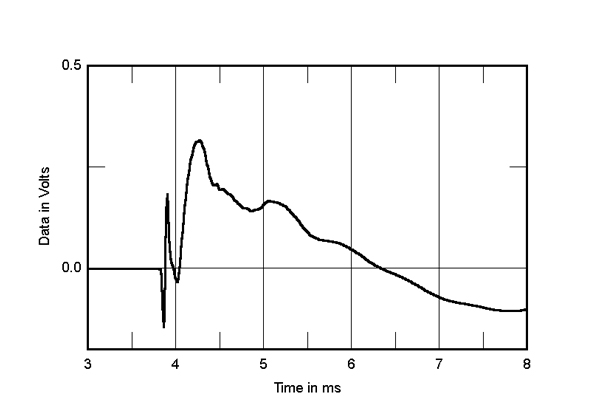

In the time domain, the LS3/5a Gold Badge's step response on the tweeter axis (fig.11) is basically the same as that of all versions of the LS3/5a that we have reviewed. The tweeter is connected in inverted acoustic polarity, the woofer in positive polarity, and there is a ripple in the decay of the woofer's step that correlates with a ridge of resonant energy centered just above 1kHz in the loudspeaker's cumulative spectral-decay plot (fig.12). This ridge is less prominent than with the 2015 Falcon LS3/5a, and I would expect that the slightly nasal coloration that is associated with this behavior, which has been a consistent feature in the LS3/5a's sonic character, will be less audible with the Gold Badge.
The Falcon LS3/5a Gold Badge's measured performance reflects the design's pedigree and confirms that 46 years after the introduction of the original, this is still a competitive loudspeaker.—John Atkinson
Footnote 2: You can find Stereophile's complete coverage of the LS3/5a, starting with J. Gordon Holt's March 1977 review here. A brief essay on the design that I wrote in 2005 can be found here. The late Art Dudley reviewed modern versions of the LS3/5a manufactured by Graham and Rogers in one of his final "Listening" columns, published in April 2020.
Footnote 3: EPDR is the resistive load that gives rise to the same peak dissipation in an amplifier's output devices as the loudspeaker. See "Audio Power Amplifiers for Loudspeaker Loads," JAES, Vol.42 No.9, September 1994, and stereophile.com/reference/707heavy/index.html.
Footnote 4: My thanks to the Italian Outline company, who used to manufacture the ST-2 computer-controlled turntable I have used for the past 30 years for my dispersion measurements. The 10m cable that connects the turntable to its ET-1 control box broke (again) and the 6-pole DIN connector at the turntable end had fractured and couldn't be repaired. Outline initially told me that they had no spares—the turntable had been discontinued 13 years ago—but a couple of days later they let me know they had found a replacement cable in a box in their warehouse. It arrived in time for me to use for this followup.
Footnote 6: Using FuzzMeasure 3.0 and a 96kHz sample rate, I average 20 1/6-octave–smoothed spectra, individually taken for the left and right speakers, in a rectangular grid 36" wide by 18" high and centered on the positions of my ears.

This loudspeaker would be the only LS3/5a to be in the Stereophile Class A Recommended Component List rating.
Just preliminary checking. It is an excellent review about a pair of loudspeaker.
Thanks to Falcon.

Thank you Herb for this very interesting update. It would be helpful to hear your thoughts on how its now refined sound compares to the LS50 Meta.

LS50 Meta enjoys a very good reputation, including on these pages here at Stereophile, A-rated with caveat of limited low frequency output (as with any little monitor with a little midwoofer, it lacks the Vd needed for low frequency SPL, a problem shared with the little LS3/5A) in their 2021 recommended components listing, and the LS50 Meta is priced at $1.5k per pair which is half the price of the little LS3/5A monitors under review.
That leaves enough money on the table to buy an Audiophonics LPA-S400ET stereo amplifier (€1,124.17 plus S/H), rated at 400W per channel into 4_Ohm loads. which uses two of the excellent Purifi Eigentakt 1ET400A amplifier modules.

$2.9k will get you a nice pair of Salk Songtower RT loudspeakers, a variant of the Songtower that utilizes a RAAL ribbon tweeter instead of the original variant's Hiquphon OW2. Those are floor standers, replacing the space-wasting stand with a TL enclosure. The fancy bespoke veneer is an upcharge.


I heard them in London ( 1980ish ) and purchased immediately, there was never anything else like them ( at the time ) other than Quad 57 ( acutely limited and all that ).
Raymond Cooke at KEF was selling the little drivers to many folks including LINN that produced the beautiful clone called the KANN.
The LS3/5a inspired manufacturers, it is still a leading Branding, all on it's own. I owned & sold the range of BBC Monitors, the tiny 3/5a outsold everything.
Pro-Ac refined ( and continues to refine ) the tiny monitor with the Tablette Series, which has always outperformed the little 3/5a ( in my book ).
The LS3/5a and the LINN Sondek are the beautiful beginnings of our wonderful Hobby, they both remain outstanding performers, I could've lived a happy life if I just kept these speakers and the LINN player.
But changed standards in music engineering brought 16/44, there is no going back!
Besides, the LP12 is now $20,000 with the 3/5a at $3k which is well out of reach of College Graduates carrying $250,000 student debt & no abundance of paying work. ( unless they move to China )
Tony in Venice Florida ( all the way out of lockdown & FREE )
ps. this is another gifted & insightful creation from Mr.HR -- Mr.JA1 is reviewing an Italian Loudspeaker demonstrating why he's been such an outstanding Audiophile & Reviewer of the Year since the 1980s! Phew!!! This is why Stereophile is such an important Magazine.
ps.2 ). SCHIIT is running Full Page Advert in Stereophile with just a picture of my Gulf of Mexico Surf. This reminds me of 1980s HFN&RR Pioneer full page fold out adverts, it's beautiful ART!

A brand new Majik/LP12 is $4995.00.
Michael in Pittsburgh...whether in lockdown or not...I am FREE.

Thanks for writing,
I hadn't considered Linn's range of prices for their Sources ( as they like to call them ).
My old friend , the LP12 , now seems to have quite a price range. I just had a quick look at Linn's web page descriptions of the possibilities for LP12 building.
I am an 'Official' LINN fan boy despite not knowing much about today's designs and offerings.
Linn has always had the highest integrity as a Company, featuring High Quality Products made by Loyal Employees at fair Prices ! LINN is one of the all time greats!
I could live with an original pre-valhalla LP12.
but...
I was one of VPI's dealers and love their players too, I loved working with Shelia Weisfeld.
All around, I loved working with record players, Arms and Phono Cart. especially MC Koetsu which I ended up collecting.
Tony in Venice Florida

Yet again, this 'flute-and-female-vocals' wonder is trumpeted in the audiophile press, and yet again its greatest failing is omitted from discussion. Apparently, the "...LS3/5a's shortcomings include: • It cannot play loud, • It compresses macrodynamics, • It can sound grainy". You'll get no disagreement from me there.. However, you forgot to mention the following: • It cannot play bass-frequencies.
Many people who read Stereophile and consider themselves audiophiles will have a nodding acquaintance with the type of music that HR listens to and uses as test material for his reviews, yet the vast majority of those readers will have the wideband (i.e., rock) music that HR does not use and that exposes something like the LS3/5a for the unfit-for-purpose device that it is.
I listened to this venerated Lada of a loudspeaker with such music 40 years ago while demoing speakers to go on the end of my STD/Hadcock/CA 252 system, and it was as unforgettable an experience as it was hilarious. Over that day (and it did last all day), I auditioned the Rogers (LS3/5a), Linn (Kans), Mission (770s), AR (18s), JBEs, Mordaunt Short's (I forget the model name), among others. The LS3/5A was first off the block and the reason that the demo took all day (at the splendid 'Simply HiFi' in Hull) because the demo guys were so embarrassed by the performance of this vaunted speaker that they weren't going to let me leave until they had found something that played full-spectrum music capably -- a need that 40 years on seems to have been forgotten.
So why was it so bad? Well, I took my latest LP purchase along with me -- 'Faith' by The Cure, and played the first track ('The Holy Hour') with its six-string bass intro on the LS3/5a. The level was modest and can't have been more than low-80s db, yet the sound coming from the Rogers left me speechless and laughing -- the 'bass'-driver bottoming-out on every note, masses of audible distortion, physical clunks as that tiny B110 thumped against its end-stops. The red-faced demo guys lifted the stylus and then proceeded to go through every cab in the shop to find one that played music properly. Don't even think about trying to play Peter Gabriel IV on this jokey speaker (an LP that most every audiophile will have in their collection, no?).
I have never forgotten that experience and always laugh when I see reviewers gushing over this pup in the modern press, more so when I see the absurd amounts that people are prepared to hand over for it. I would think that John Atkinson would regard the ability to play the lowest string of a bass-guitar (is it 32Hz in the case of a six-string?) at modest levels as essential in a speaker with any pretense to high-fidelity, yet the LS3/5a continues to do the rounds approvingly. Really, of what matter is its midrange and imaging when it sounds like an overdriven clock-radio when faced with full-spectrum music...? It doesn't have to excel at such music, but it should at least be able to play it without dying on its ass.
A navel-gazing novelty...

I’ll agree with you on one thing you’ve written here in regard to the Falcons - I would never consider playing Peter Gabriel

... but it's about Phil Collins, not Peter Gabriel. It's from the movie Sing Street: "No woman could truly love a man who listens to Phil Collins." Never heard similar condemnation of PG, however!
Best Wishes,
Jim Austin, Editor
Stereophile

I can testify to the inaccuracy of this movie quote, Jim: Some women do truly love some men who listen to Phil Collins. And the fragile grandeur of PG. And the intensely musical wholeness of 3/5's. It's about why men listen, imperfections and all. To early Collins, that is ;-).
Thanks, Herb.

... I suspect that you're correct. :-)
Jim Austin, Editor
Stereophile

I didn't know anyone else saw that movie. It was a good one and I'd forgotten that quote. I laughed out loud when he said that. (and then I moved my Phil Collins album to the back)

Has been known to cause EQ problems. It will be interesting to see JA!'s measurements.

Hi
This foam surround is to reduce the undue reflections of the tweeter's mid-high frequency soundwaves at the speaker box surface & corners.
That said, such foam surround can't do much to turn around the overall performance of the minis.
Jack L

Hi
Indeed appreciate yr cool comment about these $3,000 hot Falcon minis. I agree!
Minis like Rogers or whatever crones couldn't & can't handle decent bass performance. This is physics: too small 'woofer' in a too small box.
FYI, my front KEF 2-way standspeakers are still one of Raymond Cook's early famous brainchild's: 0.5cu ft sealed box much larger than the Rogers minis. No KEF B110 'woofers', thanks goodness.
A glance at Falcon Goldbadge X-over board, I already find out what contributed its bass 'shy' besides its too small 'woofer' in is too small box. It should not use "transformer" like device which did not used in any previous Rogers designs. Any transformer type network limits its bass response due to limited inductance of the small winding. Also the copper tracings of the PCB are way too tiny, thus limiting large bass current flow., IMO.
I believe I know enough about KEF designs as I upgraded my KEFs like nobody else business: replaced it's T15 dome tweeter (which rang like hell!) with Norwegian SEAS soft frabric dome tweeter (same tweeter used by Dynaco A10), replaced its micky-mouse like tiny X-over board with my custom-design/built bi-wired X-over on a large fibreglass PCB with large copper tracings for bass current flow; replacing all crappie electrolytic caps with high current polypropylene caps. I've purposely retained the factory ferrous cored inductors to retain KEF sonic signature !!!
To overcome the 'shyness' of sub-bass performance of my standspeakers, I installed 3 active subs: L, R, L+R channels hooked up direct to my design/built triode tube phono-preamp.
So I can heartily enjoy sub-bass church organ music & rock music ith synthetic bass notes, enough to rock my 700sq ft basement audio den no sweat !!!!
Jack L

... the crossover network and quoting from the Falcon website:
"The matched 15 ohm BBC Specification FL6/23 filter networks are made exclusively by Falcon in the original transformer-style to BBC Specification and contain inductors specially made in Britain for Falcon to the original specification."

...... to BBC Specification " quoted Ortofan.
So what? In fact, if you check again the schematics of other Rogers models, non of them got tapped transformer type HF filter except LF6.
But we were on the bass performance of Rogers & whatever crones thereafter. It is the KEF 6.5" too small 'woofer' in a too small box that can't deliver good bass. This is physics.
Jack L

... published in the original report issued by BBC R&D on the design of the LS3/5a, you will see a tapped auto-transformer included in the HF circuit.
http://downloads.bbc.co.uk/rd/pubs/reports/1976-29.pdf
If the transformer-style inductors in the LF section bother you, then Stirling Broadcast has produced their "V3" "ultra-low distortion" version with air-core inductors.
http://www.stirlingbroadcast.net/ls35a_v3.html

... but only with active electronics. Extend the lower f3 limit with EQ and then cut everything below f3 to free the woofer of playing low notes it cannot handle in the first place. The cut reduces excursion and allows the woofer to play louder and with less IMD. You can reach 50 Hz f3 with a 5" woofer this way. Just take the chance and listen to a Neumann KH120 or a Genelec 8030.
Using DSP one can go further and adjust f3 dynamically: at lower SPLs f3 would be lower than at high SPLs. I wouldn't see this as true high fidelity because peaks in SPL lose bass content, on the other hand low SPL listening gets more bass (and playing louder does not destroy the woofer). Such a feature could/should be switchable.
The best solution however is to add a subwoofer.

Hi
Bingo !
The better than your "best solution", would be to install 3 active subs instead of only one, as I posted above.
Why? There are an array of microphones (L, R & L+R channels) overhung the performance podium of any concert halls. Each mic picks up tons of bass & sub-bass music & low frequency reverberations. So 3 active subs would be needed to retrieve the missing bass music as already picked up by the mics & recorded in the storage media.
So don't take for granted for whoever subwoofer 'experts' telling music below 500Hz or whatever lower would be non-directional to our ears.
My critical ears confirm one single active sub can't cover the entire spectrum of the music performance recordings.
Take the example of the huge symphonic poem: Richard Strauss' Also sprach Zarathustra, which is made so famous after being used as the theme for the movie: "2001: A Space Odyssey".
The crawling deep bass notes of the pipe organs + bass drum + double bass instruments starting the "poem" music is so so convincing with my 3 subs ON, each set to 20Hz low-cut frequency & only half volume.
Listening is believing
Jack L

This is certainly true, but IMHO not because of the recording side (the 3 channel recording you've described). Each sub creates nulls and zeros at the listening position, depending on room size, sub position and frequency. You need to position the subs such that nulls of one sub at the listening position are compensated by at least one of the other subs which does not has a null at the listening position. This flatens the low frequency response quite a bit.

Hi
Good concern!
I placed my L sub at the L wall corner about 4-5 feet off the back of my L channel standspeakers & same for the R sub.
I tested each sub with 20Hz squarewave signals (instead of sinewave test signals to avoid undue standing wave resonances) from my signal generator & measured the SPL of the squarewave sginals arriving my sweet spot with my digitla sound level meter placed at my ear level.
I adjusted the positions & oriented the woofer facing directions of the L & R subs at their wall corner positions to get the even SPL at my sweet spot. Free from "null" & "zero" you suggested.
Careful audition using deep bass music to ensure clean, firm & steady unfuctuated sub-bass reproduction without audible messy resonances at my sweet spot.
The centre (L+R) sub is positioned exactly midway between the L & R front standspeakers.
One very critical thing most subwoofer owners neglect & I am dead serious with it: NO sub should be placed direct onto the floor to avoid the sub box vibration reaction back up from the floor underneath.
All of 3 subs are each placed on a square-ring shaped stand (made of solid lumber 1.5"x1.5" ) with 3 supporting steel spikes enchoring the fully-carpetted concrete floor of my basement. So my subs are virtually 'floated' off the floor, eliminating the box vibration reaction backup from the floor.
So my 3 subs work 'hand-in-hand' like a chime - clean & firm sub-bass notes - no sweat !
Nothing comes easy, my friend.
Listening is believing
Jack L

Hi
..should be at the exact midway of each side wall.
But no way for my room situation. So I have had to settle down with this lousy wall corner location of my L & R subs.
Jack

While I suspect that you and most everybody else with interest in the topic have probably already seen the pdf file archiving the presentation, "Subwoofers: Optimum Number and Locations", by Todd Welti, Research Acoustician, Harman International. I would bring your attention to that, to slides 40 and 41 on page 13, and the associated comments (file available at the following link, https://www.harman.com/documents/multsubs_0.pdf ), and to the associated AES paper, cicra 2006 (file available at the following link, https://audioroundtable.com/misc/Welti_Multisub.pdf ).
The better performing configuration for use in a rectangular room (in small room acoustics application) was as depicted in the "1/4 placement" in the image below, and was not the mid-wall "1/2 placement":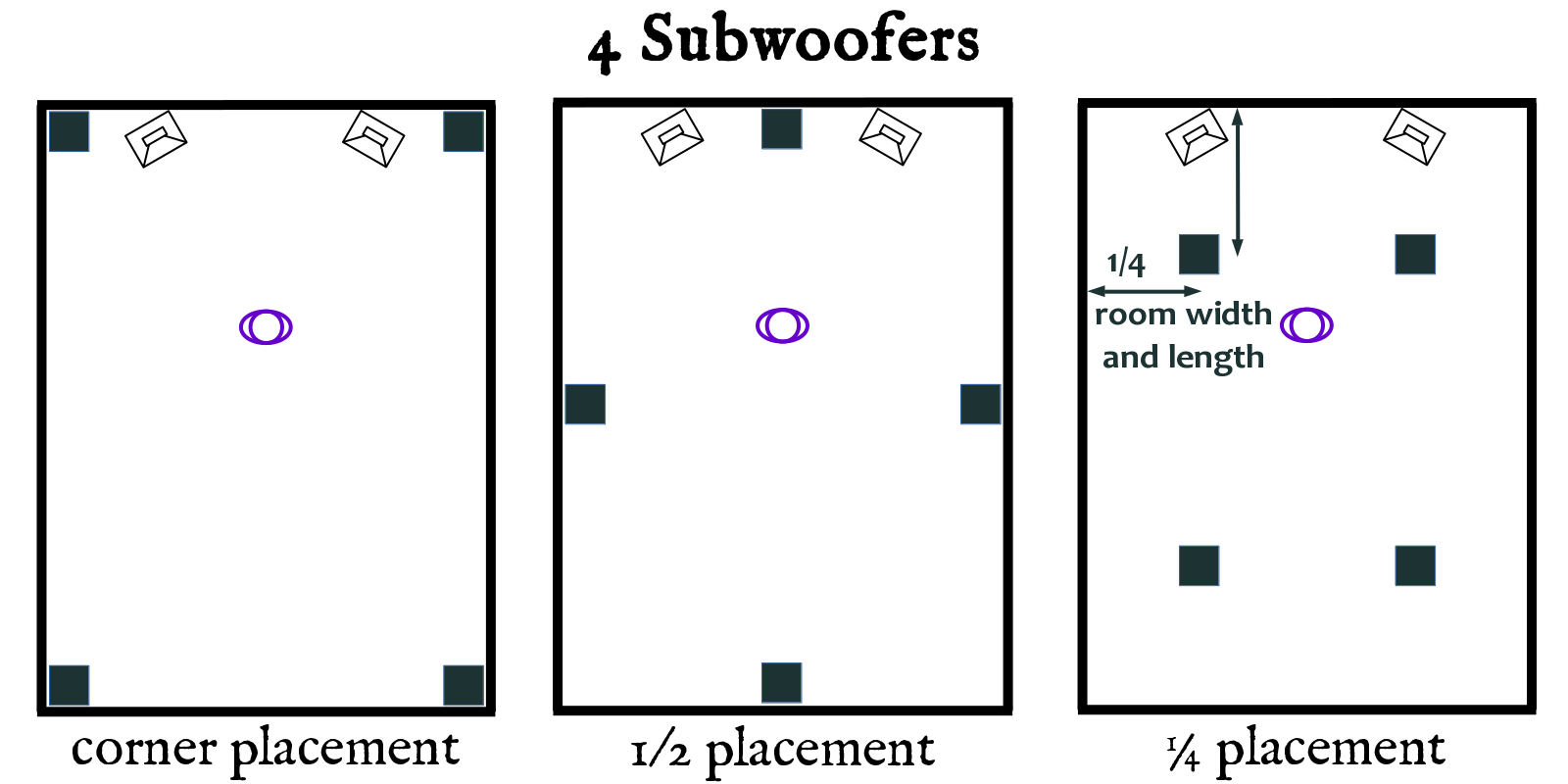
Ignore the loudspeaker placement depicted near the wall in the graphic. (Dutch and Dutch 8C is designed for that placement, but many, perhaps most loudspeakers are not.)
That "1/4 placement" locates the subwoofer sound pressure sources at pressure nodes associated with integer multiples of the 4th order harmonics of the lateral and longitudinal orthagonal room mode (and not of the vertical orthagonal room modes, or of any of the skew modes), locations which do not much excite lower orders. The "1/2 placement" at midwall as you suggest locates those subwoofer pressure sources at pressure nodes associated with integer multiples of the second order harmonics of those modes. Locating those on the floor excites all orders of the vertical orthagonal room modes.
Almost nobody does this, but raising the center of the subwoofer diaphragm to an altitude above the floor that is 25% of the floor to ceiling height places that pressure source at the 4th order harmonic of that mode, reducing excitation of lower orders. The source and floor reflection of the subwoofer radiation should remain within 1/4 wavelength into the low pass stop band, so destructive interference in the phase sum in those is not a significant concern.
Interference from Eigentones associated with modal resonances, fundamentals and harmonics, tends to be a dominant problem around and below the Schroeder Frequency (a room dependent low triple digit frequency), not above, so avoiding excitation of low order harmonics, shifting the excitation to higher orders is worthwhile effort.

Hi
A practical question: who wants to install 4 subs at home?
Jack L

......excites all orders of the vertical orthagonal room modes." quoted JRT
Hi
Let me cut the above Todd Welti's paper to the chase:
His conclusions of the very paper:
"...Two subwoofers, at opposing wall MIDPOINTS, performs very nearly as well as four at the midpoints & gives a much BETTER LF factor...If cost & aesthetics are considered, subwoofers at 2 wall midpoints is preferred."
That's was exactly what I suggested in my previous post here two subs at sidewall midway got the best LP result.
In fact, such midway-wall placement of subs was also recommended in a paper by another expert that I quoted here.
BTW, Todd Welti & A. Devantier jointly published a similar paper:
"Low-Frequency Optimization Using Multiple Subwoofers".
In the introduction of the paper, they pin-pointed the purpose of the paper: to study how to use multiple subs to enhance the "advent of home theatre & multichannel audio.."
But but I think we are all on home stereo audio in this forum, NOT multichannel audio where a multitude of audience was taken in the study as per the floor plan layouts in Welti's above conclusion of his paper.
That's is why in my last post back to you, I stated:
"A practical question: who wants to install 4 subwoofers at home?"
I think I am crazy enough to have 3 subs (L,R, L+R) installed at home for years, strictly for enhancing my stereo audio. NO home theatre audio as per Welti's papers, for sure.
Jack L

Hi
It depends on what type of music you play with them.
If you wanted to restrict yourself to light music without any synthetic bass or opera arias with piano only accomplishment, OK.
But if you listen to the music like yours truly, from Beatles to
Saint-Saens Organ Symphony at a realistic performance level, tons of bass music will be missing from yr minis assuming they could handle the sound pressure without 'bottom-up' !
That said, I auditioned a pair of Japanese brand-name mini bookshelves similar size of the Rogers, if not smaller, capable of reproducing powerful all-round music like many large brand-name loudspeakers.
A huge jaw dropper !!! Its design is, INO, revoluationary, so contrary to any conventional loudspeakers.
Jack L

Hi
Just enjoyed thru You-Tube 4K UHD steaming of Georg Telemann horn concerto performed solo in the church in Dresden, Germany, accompanied with the church pipe organ. No audience in the church, thanks to the deadly pandemic. Virtual viewing only.
The 4K broadcasted organ sub-bass notes sounded so real & powerful like I were there in the church - thru my 3 subs !!!!
Listening is believing
Jack L

I’ve had my Falcon Gold Badge for about 6 weeks now . I’m absolutely thrilled with their performance. I’ve owned many different speakers over the years ( including most of the Harbeth’s) but these little Falcons Gold Badge are a revelation. This is a fickle hobby, but I can’t imagine myself ever wanting a different speaker. BTW the Falcons powered by my Croft separates play plenty loud for me in my medium sized room . The Falcon’s limitations are technical but certainly not musical . Go Falcon !

Davip’s post is pretty much on point imo. The amount of information that is lost when a speaker cannot either produce scale or produce robust and resolved bass is enormous. The little BBC mini monitors were designed, at least in my opinion as a kludge. This design continues to be exactly that...and I believe that it should be pointed out that the severe limitations of the design mean it is basically a one trick pony, at best. Presumably if one has a very limited size room that one is working with, they could possibly be an option, but if not...why bother with them? There are just so many way better options on the market...regardless of price.

As mentioned by some who have criticized this speaker, yes, it does not do bass, or image as well as others or even give an etched, hyper detail soundstage, but that isn't its strengths or point. They are designed for small rooms and near field listening. They are speakers that can unravel complex musical phrasing convincingly. Ok, no deep bass, and the imaging is only between the speakers; that's fine for those of us in small cramped apartments - that is all we need. I have a pair of Kan IIs, and they have been the best speaker I can have given my surroundings. Also, they are perfect for chamber works and jazz ensembles; they are not bad for large-scale symphonic works either. Some of us do not need real-world sound pressure at high volumes to enjoy our music. I have not yet heard this particular model but have heard previous generations, and they do serve a purpose and quite a useful one for us in 350 square foot listening areas.
I want a pair.

Hi daveyf
I agree small bookshelves can't deliver good bass: using too small 'woofer' in a too small box. This is physics.
Yet I disagree to yr comment that Rogers & the like were assembled like a "kludge".
On the contrary, I like very much the high, mid & mid-low sound of properly design/built small bookselvers, e.g. the Rogers, when PROPERLY mounted on tall sturdy floor stands vs many many floorspeakers.
Why? Small speakers when mounted on tall stands acoustically like hanging in the air, & allow soundwaves emitted from the driver units circulating FREELY around the speaker box with minimum box surface & corners diffraction considering the rather short wavelengths of the high mid frequency soundwaves.
This will provide excellent soundstaging, pricision imaging & airy spatial effect that many many floorspeakers cannot match due to their bulky size.
We got to know our ears are very sensitive to sound of high & mid frequencies (4KHz is the most sensitive frequency to human ears). But we are pretty dumb at low frequencies. Not many floorspeakers can deliver bass strong enough to match closely with the level (phon) of mid/high frequencies our ears perceive.
So active subwoofer(s) are the 'white knight' to rescue such bass-shy situation.
For better sound, I would definitely go for bookshelvers on tall stands or standspeakers with active subwoofer(s) rather than large floorspeakers.
Jack L

Hi Jack L,
I somewhat agree with you regards listening to small speakers on stands with active subs vs. large floor standers. However, this is entirely room dependent. My system, which resides in its own dedicated yet very small room, is put together exactly as you suggest. BUT, and here's the thing, the size of the room greatly limits the sense of scale that the speakers can portray, wherein a large floor stander in a large room can portray scale...although in many cases the large speaker cannot portray intimacy as well.
OTOH, a speaker the size of the LS3/5A is truly restricted...simply due to physics. IF one has the option of a slightly larger space, then I think to use them probably doesn't make a lot of sense.

Hi Daveyf,
....to audition some design-built really RIGHT mini bookshelf loudspeaker which would sonically blow away many many large famous brandname floorspeakers.
A few years back, I had this opportunity to audition one such not-so-well-known commercial branadname mini loudspeakers made in Japan.
A huge jaw dropper !!!!!!!! More details later.
Listening is believing
Jack L

Are these BETTER than the new Rogers LS 3/5A's The NEW KING of MINI MONITORS ?
https://www.dagogo.com/rogers-ls-35a-classic-mini-monitors-review/

IMO, they blow away any brand-name minis in the marketplaces.
Jack L

Hi All,
Do you know which stands Herb used for his review?
Could folks please advise on which stands are suitable for the Falcon LS3/5a?
What do users have - mass loaded or open frame?
Thanks
Abadan

Hi Abadan,
I have and much enjoy a Falcon LS3/5a GB on Graham dedicated stands and I am verry happy with sound results.
You can find them at a reasomable price.
Hope this helps.
Regards
Giorgio

Hi Giorgio,
Thanks for your reply.
I found that the Falcons respond well to mass loaded stands, and ended up buying the Falcon own brand stands to go with my new LS3/5s Gold Badge. They are quite expensive compared to other brands, but I do like the way the combination sounds and looks.
Regards
Abadan

I have only compared light to heavy and tried different heights, but I purchased my HEAVY, four-post, 24" Sound Anchor Reference stands, because they seemed perfect with my original Rogers LS3/5a.
hr

Hi Herb,
Many thanks for your reply.
In the end, I purchased the Falcon Acoustics matching stands for my LS3/5a Gold Badges. They are 24" and weigh about 16 Kgs.
On a different note, as a subscriber to Stereophile, I very much enjoy reading your reviews.
If the raison d'être of a hobbyist magazine is to inform, educate and entertain; you do it splendidly.
Best wishes for Christmas and a Happy New Year.
Abadan